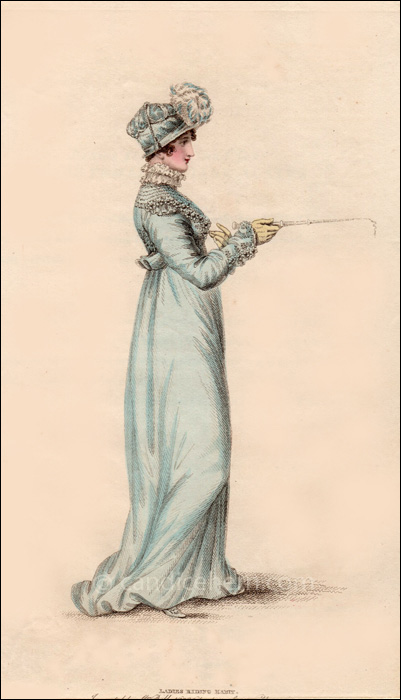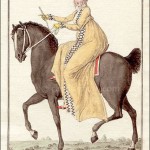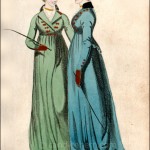La Belle Assemblée, October 1815.
“Ladies Riding Habit”
This pretty habit, courtesy of Mrs. Bell, has all the standard elements of a lady’s riding habit, including the short peplum at the back of the jacket. But it is much more feminine than the habit styles of the previous decades, when masculine styles were favored. Now that female dressmakers were making habits (up until about 1812 they were made exclusively be male tailors) we begin to see a lot of very feminine embellishment. For example, the front and cuffs of this habit jacket are beautifully embroidered.
Hats were generally made specifically for habits and were not worn with other outdoor wear, like walking dresses. In this case, the hat is designed to be worn with this particular habit and none other.
The print is described in the magazine as follows:
“We are indebted this month to the fertile imagination of Mrs. Bell for a most elegant and useful novelty — we mean the riding habit which she has just introduced. Habits have, ever since they were first brought into fashion, been considered as decidedly calculated to give even the most delicate female a masculine appearance, and the wits of our grandmothers’ days were unmercifully severe on the waistcoat, cravat, and man’s hat which were then the indispensible appendages to a habit; nor has the modern style of habit making, though less masculine, been more becoming. In the one now before us we are presented with an elegant and feminine dress, which is at once happily adapted for travelling and calculated to display to advantage the fine proportions of an elegant form, while a strikingly tasteful hat adds an air of smartness, without taking from the delicacy of a handsome face.
“The habit from which our print is designed was composed of the finest pelisse cloth, the body is formed in a most novel style, and the front and cuffs embroidered with much taste and originality; a very rich lace ruff of a new and peculiarly becoming form completes the habit. The hat is composed of moss silk, and ornamented with feathers to correspond; gloves and half-boots also to correspond. The tout ensemble of this dress is striking and tasteful beyond what our descriptive powers can portray, and we have no doubt that its striking utility as well as elegance will very soon render it a general favorite. At present it is adopted by some of the most distinguished fashionables of the haut ton.”








